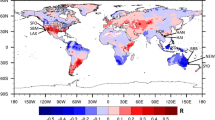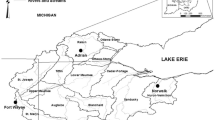Abstract
As an essential part of the hydrological cycle, precipitation directly contributes to surface runoff and river runoff formation. Simulation on precipitation variables can effectively solve the adverse effects on hydrological assessment in some areas with insufficient or even no runoff observation. With the widespread use of various weather generators, the traditional stochastic hydrological simulation methods tend to be gradually replaced. To compare these two approaches mentioned above, this paper utilizes the precipitation records from 1958 to 2011 at nine meteorological stations within Huaihe River System in Henan Province to evaluate a stochastic hydrological simulation method, SARIMA model, and two types of weather generators, WeaGETS and LARS-WG, through the comparison of statistical characteristics regarding precipitation variables, such as mean, mean square error, extreme value and coefficient of variation. The results show that (1) on the annual scale, SARIMA has a better performance to reproduce the mean and mean square error as well as the extreme precipitation events than weather generators; (2) regarding the monthly-scale precipitation simulation, SARIMA is good at reproducing the statistical properties of monthly precipitation at the average level, while WeaGETS and LARS-WG work better in simulating monthly precipitation extremes; (3) compared with weather generators, SARIMA is highly constrained by the observed records, and among these two weather generators, WeaGETS scores higher on monthly precipitation simulation under the same sample length conditions. In conclusion, the traditional hydrological simulation method, SARIMA, and weather generators, WeaGETS and LARS-WG, have both benefits and drawbacks. The appropriate choice depends on different research backgrounds and purposes.










Similar content being viewed by others
Code availability
Codes used during the study are available from the first author by request.
Data availability
All data used during the study are available from the first author by request.
References
Afshin S, Gerrit H (2003) A statistical comparison of the stochastic weather generators WGEN and SIMMETEO. Climate Res 24(3):215–230. https://doi.org/10.1016/S0308-521X(01)00108-1
Akaike H (1976) Canonical correlation analysis of time series and the use of an information criterion. In: Mehra RK, Lainiotis DG (eds) Mathematics in science and engineering. https://doi.org/10.1016/S0076-5392(08)60869-3
Breinl K (2016) Driving a lumped hydrological model with precipitation output from weather generators of different complexity. Hydrol Sci J 61(8):1395–1414. https://doi.org/10.1080/02626667.2015.1036755
Breinl K, Di Baldassarre G, Girons Lopez M, Hagenlocher M, Vico G, Rutgersson A (2017) Can weather generation capture precipitation patterns across different climates, spatial scales and under data scarcity? Scientific Reports. https://doi.org/10.1038/s41598-017-05822-y
Brissette FP, Khalili M, Leconte R (2007) Efficient stochastic generation of multi-site synthetic precipitation data. J Hydrol 345(3–4):121–133. https://doi.org/10.1016/j.jhydrol.2007.06.035
Chang XH, Gao M, Wang Y, Hou XY (2013) Seasonal autoregressive integrated moving average model for precipitation time series. Journal of Mathematics and Statistics. https://doi.org/10.3844/jmssp.2012.500.505
Chen J, Brissette FP, Leconte R (2010) A daily stochastic weather generator for preserving low-frequency of climate variability. J Hydrol 388(3):480–490. https://doi.org/10.1016/j.jhydrol.2010.05.032
Chen J, Brissette FP, Leconte R, Caron A (2012) A versatile weather generator for daily precipitation and temperature. Trans ASABE 10(13031/2013):41522
Chen J, Brissette FP, Zhang XJ (2014) A multi-site stochastic weather generator for daily precipitation and temperature. Trans ASABE 57(5):1375–1391. https://doi.org/10.13031/trans.57.10685
Dabral PP, Murry MZ (2017) Modelling and forecasting of rainfall time series using SARIMA. Environmental Processes 4(2):399–419. https://doi.org/10.1007/s40710-017-0226-y
Greco R (2012) A fuzzy-autoregressive model of daily river flows. Computers & Geosciences. https://doi.org/10.1016/j.cageo.2012.02.031
Hartkamp AD, White JW, Hoogenboom G (2003) Comparison of three weather generators for crop modeling: a case study for subtropical environments. Agric Syst 76(2):539–560. https://doi.org/10.1016/S0308-521X(01)00108-1
Kim D, Cho H, Onof C, Choi M (2017) Let-It-Rain: a web application for stochastic point rainfall generation at ungauged basins and its applicability in runoff and flood modeling. Stoch Env Res Risk Assess 31(4):1023–1043. https://doi.org/10.1007/s00477-016-1234-6
Koutsoyiannis D, Xanthopoulos T (1990) A dynamic model for short-scale rainfall disaggregation. Hydrol Sci J 35(3):303–322. https://doi.org/10.1080/02626669009492431
Lall U, Sharma A (1996) A nearest neighbor bootstrap for resampling hydrologic time series. Water Resour Res 32(3):679–693. https://doi.org/10.1029/95WR02966
Langousis A, Kaleris V (2014) Statistical framework to simulate daily rainfall series conditional on upper-air predictor variables. Water Resources Research. https://doi.org/10.1002/2013WR014936
Milly PCD, Betancourt J, Falkenmark M, Hirsch RM, Kundzewicz ZW, Letternmaier DP, Stouffer RJ (2008) Stationarity is dead: whither water management? Science 5863(319):573–574. https://doi.org/10.1126/science.1151915
Miu R, Ding J (1998) Stochastic model of daily runoff with hydro-physical concepts. J Hydraul Eng 4:27. https://doi.org/10.3321/j.issn:0559-9350.1998.04.005.(inChinese)
Mukundan R, Acharya N, Gelda RK, Frei A, Owens EM (2019) Modeling streamflow sensitivity to climate change in New York City water supply streams using a stochastic weather generator. Journal of Hydrology: Regional Studies 21:147–158. https://doi.org/10.1016/j.ejrh.2019.01.001
Prairie J, Rajagopalan B, Lall U, Fulp T (2007) A stochastic non-parametric technique for space-time disaggregation of streamflows. Water Resources Research. https://doi.org/10.1029/2005WR004721
Qian B, Hayhoe H, Gameda S (2005) Evaluation of the stochastic weather generators LARS-WG and AAFC-WG for climate change impact studies. Climate Res 29(1):3–21. https://doi.org/10.3354/cr029003
Qin XS, Lu Y (2014) Study of climate change impact on flood frequencies: a combined weather generator and hydrological modeling approach*. J Hydrometeorol 15(3):1205–1219. https://doi.org/10.1175/JHM-D-13-0126.1
Racsko P, Szeidl L, Semenov M (1991) A serial approach to local stochastic weather models. Ecol Model 57(1):27–41. https://doi.org/10.1016/0304-3800(91)90053-4
Richardson CW (1981) Stochastic simulation of daily precipitation, temperature, and solar radiation. Water Resour Res 17(1):182–190. https://doi.org/10.1029/WR017i001p00182
Santos EG, Salas JD (1992) Stepwise disaggregation scheme for synthetic hydrology. J Hydraul Eng 118(5):765–784. https://doi.org/10.1061/(ASCE)0733-9429(1992)118:5(765)
Semenov MA, Barrow EM (1997) Use of a stochastic weather generator in the development of climate change scenarios. Clim Change 35(4):397–414. https://doi.org/10.1023/A:1005342632279
Sha J, Li X, Wang Z (2019) Estimation of future climate change in cold weather areas with the LARS-WG model under CMIP5 scenarios. Theoret Appl Climatol 137(3):3027–3039. https://doi.org/10.1007/s00704-019-02781-4
Shu YJ, Jan HM, Young M (1989) Runoff simulation of experimental watershed based on the concept of variable source area. Proceedings of the Japanese Conference on Hydraulics 33:31–36. https://doi.org/10.2208/prohe1975.33.31
Srinivas VV, Srinivasan K (2005) Hybrid moving block bootstrap for stochastic simulation of multi-site multi-season streamflows. J Hydrol 302(1–4):307–330. https://doi.org/10.1016/j.jhydrol.2004.07.011
Stedinger JR, Pei D, Cohn TA (1985) A condensed disaggregation model for incorporating parameter uncertainty into monthly reservoir simulations. Water Resources Research. https://doi.org/10.1029/WR021i005p00665
Sunyer MA, Madsen H, Ang PH (2012) A comparison of different regional climate models and statistical downscaling methods for extreme rainfall estimation under climate change. Atmos Res 103:119–128. https://doi.org/10.1016/j.atmosres.2011.06.011
Vallam P, Qin XS (2016) Multi-site rainfall simulation at tropical regions: a comparison of three types of generators. Meteorol Appl 23(3):425–437. https://doi.org/10.1002/met.1567
Wang S, Feng J, Liu G (2013) Application of seasonal time series model in the precipitation forecast. Math Comput Model 58(3):677–683. https://doi.org/10.1016/j.mcm.2011.10.034
Wang Z, Fathollahzadeh Attar N, Khalili K, Behmanesh J, Band SS, Mosavi A, Chau K (2020) Monthly streamflow prediction using a hybrid stochastic-deterministic approach for parsimonious nonlinear time series modeling. Engineering Applications of Computational Fluid Mechanics 14(1):1351–1372. https://doi.org/10.1080/19942060.2020.1830858
Wetterhall F, Bárdossy A, Chen D, Halldin S, Xu C (2006) Daily precipitation-downscaling techniques in three Chinese regions. Water Resources Research. https://doi.org/10.1029/2005WR004573
Wilks DS (1998) Multi-site generalization of a daily stochastic precipitation generation model. Journal of Hydrology (amsterdam) 210(1):178–191. https://doi.org/10.1016/S0022-1694(98)00186-3
Wilks DS, Wilby R (1999) The Weather generation game: a review of stochastic weather models. Prog Phys Geogr 23:329–357. https://doi.org/10.1191/030913399666525256
Yates D, Gangopadhyay S, Rajagopalan B, Strzepek K (2003) A technique for generating regional climate scenarios using a nearest-neighbor algorithm. Water Resources Research. https://doi.org/10.1029/2002WR001769
Ye Q, Li Y, Zhuo L, Zhang W, Xiong W, Wang C, Wang P (2018) Optimal allocation of physical water resources integrated with virtual water trade in water scarce regions: a case study for Beijing, China. Water Res 129:264–276. https://doi.org/10.1016/j.watres.2017.11.036
Funding
This work was supported by the National Natural Science Foundation of China (Grant No. 52079037, 52009029), the Fundamental Research Funds for the Central Universities (Grant No. B200202032), the China Postdoctoral Science Foundation (Grant No. 2020T130169).
Author information
Authors and Affiliations
Contributions
Methodology, YLH.; conceptualization, ZPA; software, YLH and ZFL; validation, MYF; formal analysis, YLH. and WH; writing—original draft, YLH and LJY; writing – review and editing, YLH and XCJ; supervision, ZPA; funding acquisition, ZPA
Corresponding author
Ethics declarations
Conflict of interest
There is no conflict of interest regarding the publication of this article.
Additional information
Publisher's Note
Springer Nature remains neutral with regard to jurisdictional claims in published maps and institutional affiliations.
Rights and permissions
About this article
Cite this article
Yang, L., Zhong, Pa., Zhu, F. et al. A comparison of the reproducibility of regional precipitation properties simulated respectively by weather generators and stochastic simulation methods. Stoch Environ Res Risk Assess 36, 495–509 (2022). https://doi.org/10.1007/s00477-021-02053-6
Accepted:
Published:
Issue Date:
DOI: https://doi.org/10.1007/s00477-021-02053-6




